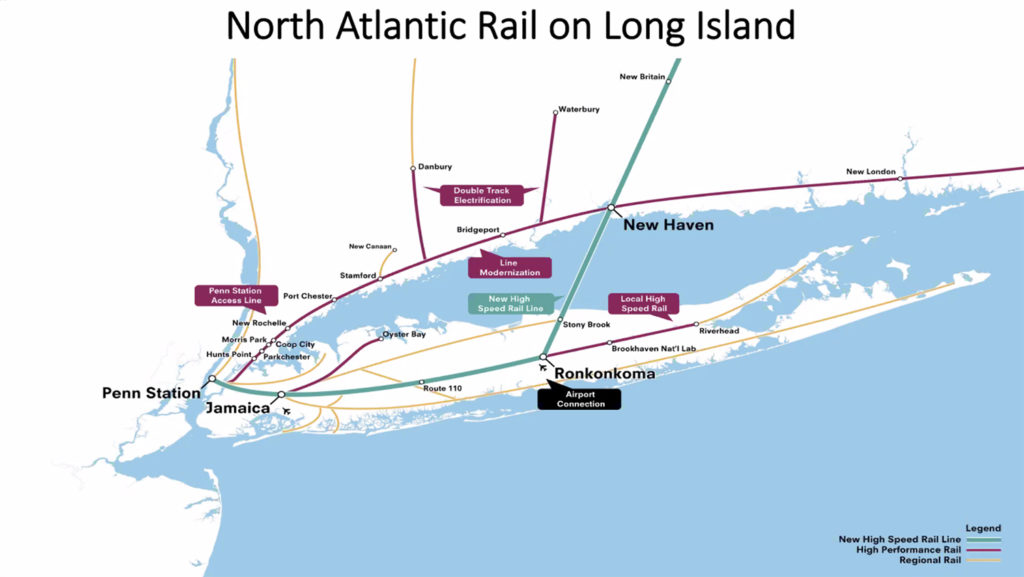Could a high-speed rail transform transportation in the Northeast?

An ambitious proposal to bring “world-class” high-speed rail to the Northeast, including a 16-mile rail tunnel that would connect Long Island and Connecticut, could provide a critical boost to the East End with an upgraded electrified rail connecting Riverhead to Long Island Rail Road’s Ronkonkoma hub.
A panel of officials from Suffolk County, Connecticut and Boston discussed the North Atlantic Rail Initiative during a webinar Tuesday morning, where they pitched the $105 billion, three-phase project as “transformative” for the future of the region. The high-speed rail system would see trains traveling at speeds up to 225 mph, greatly shortening travel times not only for travelers on Long Island, but to cities across the Northeast, which could generate new economic opportunities, the officials said. The new high-speed rail line would run from New York City to Ronkonkoma with a few stops along the way, then up toward Stony Brook and under Long Island Sound to New Haven, Conn. It would then connect to Hartford, Providence and Boston. The completion of the entire project could take around 20 years, officials predict.
“This is a project of national significance,” said Suffolk County Executive Steve Bellone, a panelist on the webinar. “There’s no question about that. When you think about the expenditure of taxpayer dollars, I cannot think of a more effective, high-quality investment that we can make as a nation than high-speed rail in the Northeast corridor.”
While the proposal isn’t entirely new, it’s gained additional traction from its supporters — including former Greenport Village Mayor Dave Kapell — in recent months as President Biden prepares a $3 trillion infrastructure plan this spring. Bob Yaro, former president of the Regional Plan Association, said the president’s plan will likely include funding for high-speed rail projects in California, the Pacific Northwest, Texas and in the Northeast Corridor between New York City and Washington, D.C.
“Some of these are going to be in the hundred billion [dollar] range,” he said. “We thought it was important to take this opportunity, which could be a once-in-a-lifetime opportunity for us to make a major infrastructure investment.”
Mr. Yaro said they hope the federal government picks up the entire cost, or close to the entire cost, for the project. He said the estimated cost represents about 3% of the total $3 trillion federal infrastructure plan and the cost is on par with what similar projects around the world have cost. He added that the seven-state Northeast region sends about $79 billion to Washington, D.C., every year, according to the Rockefeller Institute of Government in Albany.
“We think that we merit this kind of investment,” he said.
Mr. Bellone spoke to the benefits the project would bring to the East End, including Enterprise Park at Calverton, downtown Riverhead and the redevelopment efforts in Riverside. The project would add an electrified main line connecting LIRR’s Ronkonkoma and Riverhead lines, which are currently served by diesel trains.
“This is a real connection to the East End,” Mr. Bellone said.
He said even without a high-speed rail component, the electrified rail would be a “huge project for the region, for Long Island, for the East End.”
The Riverhead extension would feature a new stop at Brookhaven National Laboratory in Upton, Mr. Yaro said. He said one of the goals of the program is to connect big research institutes throughout the Northeast.

The renewed push for the project comes as Riverhead Town officials are seeking a master developer for the parking lot area adjacent to the LIRR station on Railroad Avenue.
The officials who spoke on the webinar said they believe the high-speed rail proposal differs from past initiatives to build a tunnel or bridge since it’s rail-only and would not include automobiles. Automated tunnel-boring machines would be used to excavate the tunnel underneath Long Island Sound, Mr. Yaro said.
“More than 100 tunnels longer than this one have been built around the world in the last 20 years,” he said. “It’s eminently feasible.”
He cited a Stony Brook University oceanographer as saying the project would have zero impact on the Sound’s environmental resources. The portals to the tunnel would be about a half-mile back from the shore.
Mr. Bellone said the mass opposition to prior proposals centered on people not wanting tens of thousands of cars traveling through specific neighborhoods en route to a bridge or tunnel.
Officials said they have explored the possibility of the high-speed line being used for freight during off-peak hours, which could alleviate some congestion on Long Island roadways. Mr. Yaro said the rail line could possibly be used to carry packages from FedEx, for example.
A trip from New York City to Boston on the high-speed rail line would take about an hour and 40 minutes, Mr. Kapell said.
Mr. Yaro said the project’s supporters proposed that Congress establish a new federal/state partnership, North Atlantic Rail Inc., to build the project. Some of the upgraded tracks could be transferred eventually to the Metropolitan Transportation Authority, for example.
“We think this can be operated on a break-even basis and we’ll be able to have first class and business class services on every train that will cross-subsidize the coach services that will be 70 or 80% of the passengers on every train.”
The only high-speed rail service currently operating in the United States is Amtrak’s Acela Express, which can travel at speeds up to 150 mph. High-speed rail crosses international borders in Europe and are common throughout Asia.
“My message today to all of you is that we can do big things,” said Doug McGarrah, co-chair of Foley Hoag’s Real Estate and Development Practice. “We have to have the will and the imagination and the vision to do it.”
Mr. Kapell spoke about the historical context of the connection between Long Island and New England and how in the 19th century the first rail connection between New York and Boston ran through Greenport and by steamship across the Sound.
“We need to return to the kind of big thinking that produced America’s foundational infrastructure like the transcontinental railroad, the interstate highway system and our own Long Island Rail Road,” Mr. Kapell said. “It’s back to the future for Long Island.”








